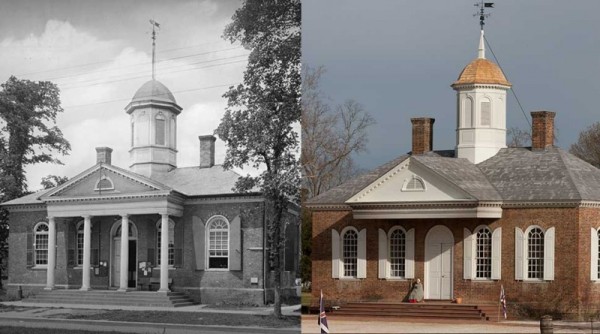 The Courthouse was built in 1770 and 1771 on Market Square. It was here that Williamsburg’s citizens assembled at 1 p.m. on Thursday, May 1, 1783, to celebrate the end of the war with England – just as they had gathered seven years earlier to hear lawyer Benjamin Waller proclaim from its steps the Declaration of Independence. The Courthouse served the Williamsburg community for more than 160 years. Confederates used it as a hospital after the Civil War Battle of Williamsburg, and by the time they carried off their wounded, the doors and windows were gone as well – used perhaps for firewood….
The Courthouse was built in 1770 and 1771 on Market Square. It was here that Williamsburg’s citizens assembled at 1 p.m. on Thursday, May 1, 1783, to celebrate the end of the war with England – just as they had gathered seven years earlier to hear lawyer Benjamin Waller proclaim from its steps the Declaration of Independence. The Courthouse served the Williamsburg community for more than 160 years. Confederates used it as a hospital after the Civil War Battle of Williamsburg, and by the time they carried off their wounded, the doors and windows were gone as well – used perhaps for firewood….
Throwback Thursday: The Tayloe House
The Tayloe House was constructed between 1752 and 1759. Col. John Tayloe, one of the wealthiest men in 18th-century Virginia, purchased the property in 1759 for 600 pounds, a very high price for a frame house at that time. Tayloe probably used it as a town house during the years he served on the Governor’s Council….
Throwback Thursday: The William Lightfoot House
 The William Lightfoot House stands on the south side of Duke of Gloucester Street, across the street from the Ludwell-Paradise House. This part of the Duke of Gloucester Street was less commercially attractive in the 18th century than the east end since it was farther away from the Capitol. The lots were not subdivided, so this area appears to have more open space. The William Lightfoot House is one of the 88 original buildings in the Revolutionary City. It belonged to a Yorktown merchant whose business brought him to Williamsburg frequently enough that he built a home to use during his visits. Today the house serves as a private residence….
The William Lightfoot House stands on the south side of Duke of Gloucester Street, across the street from the Ludwell-Paradise House. This part of the Duke of Gloucester Street was less commercially attractive in the 18th century than the east end since it was farther away from the Capitol. The lots were not subdivided, so this area appears to have more open space. The William Lightfoot House is one of the 88 original buildings in the Revolutionary City. It belonged to a Yorktown merchant whose business brought him to Williamsburg frequently enough that he built a home to use during his visits. Today the house serves as a private residence….
Pipes are Straightened
Before treatment, the pipes were bent, torn, and twisted.
By John Watson
The badly twisted, torn and mangled pipes are among the more daunting problems to be solved in the treatment of the “Tucker” organized upright grand piano. A conventional approach to restoration would probably involve replacing them with new ones. Some restorers have even melted down original pipes to make new ones, copying the old dimensions as a method of preserving them. But as we will see, dimensions and even the metal alloy itself are not the only, or even the main things we are here to preserve.…
A house of a different color
The shade on the Capitol before it was painted (left) and then after.
By Dawn Chase
In today’s world, the color you paint your house is a matter of aesthetics and not much else.
But in 18th-century Colonial Williamsburg, paint color reveals much more. It advertises the status of a building’s owner. And it shows that early Virginians, from the beginning, created their own vibrant style that set them apart from the British motherland….
The Pipe Treatment Begins
By John Watson
The first step: Inventory the pipes and determine what is missing. For this, we turned to veteran organ-pipe maker Louis Dolive….
A Conservation Pipeline
By John Watson
Restorative conservation of the Tucker instrument will begin with one of our more daunting challenges: to straighten the severely damaged metal pipes. While the wood pipes survived in relatively good condition, the metal ones were hardly recognizable as organ pipes. All were crushed and folded so even the longest pipe could fit in a 24-inch long cardboard box.
…
Bunker Hill and the Colonial Williamsburg Connection
June 17 is the anniversary of the first major military engagement of the American Revolution, the Battle of Bunker Hill. On a clear day in Boston in 1775, British forces made a third and successful attempt to dislodge Patriot militia holding Breed’s Hill.
…
Throwback Thursday: The Powell House
Benjamin Powell was a carpenter who became a contractor, built a couple of Williamsburg landmarks, and enjoyed the company and counsel of some of 18th-century Williamsburg’s leading gentlemen. He acquired his property at the east end of the city in 1763 and for nearly 20 years pursued from there the career of an “undertaker” – as contractors were called in those days….
Throwback Thursday: The Roscow Cole House
The Roscow Cole house has anchored the east end of Market Square since about 1812. It is named for the merchant who built it and owned it until 1854 and replaces a house that can be traced back to 1719. The original structure once sheltered a tailor, a wigmaker, a doctor-apothecary, a barber-surgeon, storekeepers, and two dentists, one of whom worked on George Washington’s teeth. Among its early owners was gunsmith James Geddy Sr.
…